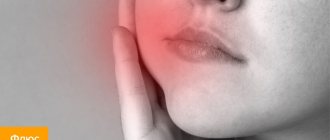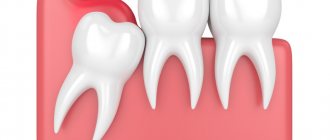Author of the article:
Soldatova Lyudmila Nikolaevna
Candidate of Medical Sciences, Professor of the Department of Clinical Dentistry of the St. Petersburg Medical and Social Institute, Chief Physician of the Alfa-Dent Dental Clinic, St. Petersburg
Expecting relief from pain from going to the dentist, patients sometimes leave the office confused - why hasn’t the pain completely gone away? It can be present for several hours or last much longer.
Why does a tooth hurt after filling?
The filling that the doctor places on the treated tooth should exclude the possibility of disease. If you feel pain after filling, the reason may be:
- The body's natural reaction to outside interference. Even after proper treatment, such a phenomenon may occur, which is periodic in nature. The pain in this case does not increase or become too severe; it can last from 2 weeks to 2 months.
- Caries is not completely cured. The tooth tissues become inflamed, and the tooth hurts after filling with aching pain. In this case, it is necessary to contact the dentist again to prevent further complications - inflammation can affect the dental nerve (pulpitis develops).
- Chronic or developing pulpitis that was not identified during the diagnostic process before the start of treatment.
- Incomplete treatment of tissues affected by inflammation during periodontitis. Treatment of periodontitis is not limited to one day, it is quite complex.
- If the filling is installed incorrectly (either at an insufficient level, or is large and puts pressure on other teeth or gums). Often a tooth hurts after root canal filling for this very reason. Damage to the filling can occur due to insufficiently high quality filling material or failure to comply with the recommendations of the dentist.
- Slight pain may be felt due to tissue injury during the process of tooth filling. It will take some time for healing to occur.
- The sensitivity of teeth after filling always increases significantly, and discomfort, manifested in painful sensations, can be the result of insufficiently correct implementation of one of the treatment procedures - drying the inner dental walls (over-drying or under-drying). If the walls of the tooth are not completely dry when installing the filling, it does not adhere well in damp places, which leads to the development of inflammation and pain.
- Allergic reaction to the filling material.
It is much easier to identify pathologies after dental treatment if all the dentist’s advice and oral hygiene rules are followed.
Attention! Dentists recommend that their patients have a small snack before going to the dental office, so that due to the lack of glucose that occurs during treatment, fear and the vasoconstrictive effect of the drugs, they do not experience a semi-fainting state during the treatment.
How long after filling should I abstain from eating?
Modern fillings contain epoxy resin, which ensures that the new filling quickly hardens into the desired shape. Light-polymer fillings harden almost instantly, while those made from chemical materials take no more than an hour. Therefore, after filling a tooth, you can eat food immediately.
When installing a temporary filling, a longer period of time abstaining from eating is required - at least 2 hours.
Severe pain after removal and surgeon error -
When a tooth has been removed, the gums hurt so much that even strong analgesics help little - the reason most often turns out to be the incompetence of the surgeon. Unfortunately, many surgeons do not strive to minimize trauma to bone tissue and gums during the removal process, which leads to severe pain. Below we list the main medical “flaws” in the process of tooth extraction -
- When cutting out bone with a drill - according to the rules, when cutting out bone around a tooth, the doctor must use a surgical handpiece that supplies coolant to the drilling area.
In 90% of cases, handpieces without such cooling are used in surgical rooms (24stoma.ru). As a result, the bone suffers a thermal burn and superficial necrosis, and the patient suffers acute pain after removal. If you have had a bone cut out and your gums hurt after tooth extraction: what to do in such a situation will depend on the condition of the socket of the extracted tooth. If the clot is dense and there are no symptoms of inflammation other than pain, you should wait and take strong NSAID-based analgesics. If the socket is empty and there are signs of inflammation (see below), you need to go for a second visit to the dentist and clean the socket.
- Sharp edges of the bone stick out from the socket (Fig. 4-5) - if the bone walls have sharp edges after tooth extraction, then they can injure and break through the mucous membrane (Fig. 4), and even stick out from under it. Or if the interradicular bone septum of multi-rooted teeth has a large height, then it may not be completely covered by a blood clot, protruding from under it.
The origin of this problem is that the doctor either did not bite down the sharp edges of the bone and the high interradicular septum with forceps, or did not apply sutures to the too mobile gum around the tooth in order to bring the edges of the wound closer together. The presence of exposed bone fragments can be determined by the characteristic pain when touching such fragments with the tongue, as well as the occurrence of acute pain in response to cold/hot water. Sometimes they can be seen with the naked eye in the mirror.
- Moving bone fragments in the wound - the surgeon can leave large, inactive bone fragments in the socket of the extracted tooth, which are formed when the tooth dislocates/rocks. Their presence can lead to severe pain and inflammation of the extracted tooth socket, as well as the need for a second visit to the surgeon to remove them.
- An incorrect removal strategy is the most common mistake. The fact is that different doctors (due to differences in experience and intelligence) remove exactly the same teeth in different ways. This leads to the fact that one surgeon can torment the patient for 1-2 hours, trying to use only forceps and elevators when removing and regardless of the trauma caused to the bone, while another will decide to immediately saw the tooth into 2 parts (removing them separately), and spending only 15-25 minutes on the entire removal.
- “Empty hole” (Fig. 6) –
if the doctor used too much anesthetic with a vasoconstrictor (this component promotes vasospasm at the site of anesthesia), then the hole after removal may not fill with blood. Doctors usually don't test for this, but simply apply a tampon and send the patient home. In an empty socket, the bone tissue will be exposed and will react with severe pain.
- The doctor did not put sutures - before removal, the mucous membrane around the tooth is peeled off from it with a trowel, which leads to the fact that the edges of the mucous membrane around the socket of the extracted tooth will be mobile.
Often, even seeing the need for suturing, surgeons are too lazy to do it. Ideally, at least 1 suture should be applied even after the removal of small single-rooted teeth, not to mention multi-rooted ones. Studies have shown that suturing the socket can reduce the intensity of pain by 30-50%, reduce the risk of developing inflammatory complications by up to 90%, accelerate wound healing, and almost completely prevent the loss of a blood clot from the socket and the risk of bleeding. I can recommend to you - always, before removal, ask the doctor to suture the hole (even if you have to pay an extra 250-500 rubles for 1 or 2 stitches). This will save you a lot of nerves. - If the doctor does not prescribe antibiotics after a complex removal, there is a high risk of developing inflammation of the socket and, as a result, severe pain. Antibiotics should only be prescribed by a doctor, so you should go for a re-examination and complain about pain.
What to do in all these situations -
How long does the gum hurt after tooth extraction in these situations - normally, pain should last no more than 1-2 days after simple removal, and its severity should be mild or moderate. Moreover, pain, swelling (if it also appears) and other negative symptoms should gradually decrease. After complex removal, pain can be severe and normally last 3-5 days, but starting from the next day they will also begin to decrease.
If the intensity of the pain does not decrease within 2 days, if you feel bone fragments in the wound with your tongue, if you experience pain in the socket when responding to cold/hot water, if a blood clot has fallen out of the socket, if there is an unpleasant odor from the socket... – you need to urgently go to the surgeon for a second appointment (without waiting for your gums to become inflamed after tooth extraction).
Important: in some cases, pain can also be caused by the patient’s mistakes in how he cares for the socket of the extracted tooth. For example, very often patients begin to rinse their mouth intensively, believing that this will be better. But this leads to the blood clot falling out of the socket and causing severe pain. Read about what you can and cannot do after removal in our article: → “Memo for the patient on how to behave after removal”
My gums hurt after filling a tooth, what should I do?
If, after installing a filling, your gums are very sore and even your cheek is swollen, you cannot do without the help of a dentist. Moreover, it is necessary to contact as soon as possible so that there are no even more unpleasant consequences.
A few tips to relieve pain:
- applying an ice compress to the cheek at the sore spot for several minutes or a compress with ice cubes;
- alternate application of compresses with warm rinses from decoctions of medicinal herbs or infusions;
- painkillers;
- balms to strengthen teeth and gums.
Attention! Under no circumstances should you apply hot or warm compresses - they actively provoke inflammation and pain!
Taking antibiotics without a doctor's prescription is also extremely contraindicated, because this can lead to a decrease in immunity and complicate further treatment.
Preventive measures
After filling a tooth, during the first week, you must strictly follow the main rules so that pain does not occur, or it disappears as soon as possible:
- do not drink or eat too cold or too hot, as temperature changes provoke pain;
- every time after eating, brush your teeth and rinse your mouth with special anesthetic rinses (the ASEPTA series includes rinses with an analgesic and disinfecting effect);
- try to eat softer foods so as not to damage the periodontal tissues, and it is preferable to chew only on the healthy side;
- do not smoke, as the tooth disturbed by treatment is very sensitive in the first days.
Experts' opinion
The effectiveness of the ASEPTA series products has been proven by multiple clinical trials conducted in the country's leading research institutes.
For example, a study of the clinical effectiveness of treatment and prophylactic agents from the Asepta line in the treatment of inflammatory periodontal diseases, conducted by A.I. Grudyanov, I.Yu. Alexandrovskaya, V.Yu. Korzunina in the Department of Periodontology of the Central Research Institute of Dentistry and Maxillofacial Surgery of Rosmedtekhnologii, Moscow, made it possible to identify the fairly high effectiveness of the Asepta gum balm and the Asepta mouth rinse for moderate periodontitis. The use of Asepta mouth rinse for inflammation also turned out to be quite effective. In addition, no phenomena of mucosal irritation or brown staining of fillings were recorded. This indicates that the use of this rinse for a two-week period provides an obvious clinical effect in the absence of negative side effects.
Consumer Reviews
Mrs. Doubtfire about Asepta Active mouth rinse (irecommend.ru):
“When I was faced with a serious gum problem, this rinse was recommended to me by a dental surgeon.
Asepta Active mouthwash is a medical product and is sold only through the pharmacy chain. The instructions recommend taking breaks in use. Personally, I use it in courses and during exacerbations of gum inflammation. I've been using it for about 2 years.
The mouthwash is minty, pleasant, slightly astringent. Improvement is felt from the first use. Bottle volume 150 ml. Manufacturer: Russia, St. Petersburg. A convenient measuring cup is included.
You can (better) buy it as a set, which also includes balm and toothpaste, which comes as a gift.
I’m very happy that such products from a domestic manufacturer have appeared!”
julia-06 about Asepta Active mouth rinse (irecommend.ru):
“A very good rinse for problem gums.
She had never encountered the problem of bleeding gums, but at her next visit to the dentist she noticed that when she only lightly touched her gums, they began to bleed. So the dentist gave me a mini version of Paradontax toothpaste and advised me to use a mouthwash after brushing my teeth. Mom bought Asepta active mouth rinse.
For some reason I used to be very skeptical about such remedies, but as it turned out, in practice it helps very well. My problem went away completely, my gums stopped bleeding. I don’t even want to read the ingredients and go into its details, it’s unlikely that everything is super natural, but since it helps, I give the mouthwash a solid 5 points. Of course, each case is individual, but I will recommend it based on my experience. And the price of the rinse aid is quite reasonable.”
Sharp edges of the alveoli
Socket pain can be caused by protruding sharp edges of the socket, which injure the mucous membrane located above them. Pain appears 1-2 days after tooth extraction , when the edges of the gums above the socket begin to approach each other.
- The pain intensifies during chewing and when touching the gums;
- When you feel the hole with your finger, a protruding sharp edge of the bone is detected, and a sharp pain occurs.
This pain can be distinguished from the pain of alveolitis by the absence of inflammation in the socket area and the presence of an organizing blood clot in it.










